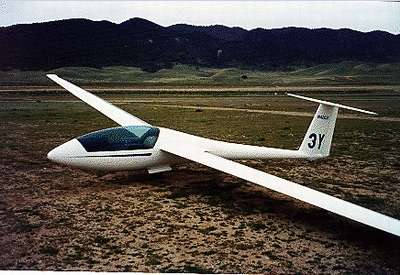Sat, Feb 25, 2012
FAA Responds To NTSB Recommendation To Avoid Mid-Airs
Many aircraft radar transponders have a button which immediately
sets the squawk code to 1200, the standard code for VFR traffic not
in communication with air traffic control. But the FAA believes
it's important for other traffic to know whether your blip is a
powered aircraft, so the code 1202 has now been designated the
standard for gliders (representative aircraft shown in file photo),
effective March 7.

The unique code joins others which are designated for special
purposes. 1255 indicates an aircraft en route to or from a
designated firefighting area. 1277 indicates an aircraft on a
search-and-rescue mission under authorization from the US Coast
Guard or US Air Force.
One impetus for the new designation is an NTSB recommendation
following the 2006 collision between a Hawker jet and a glider near
the Reno/Tahoe International Airport. Following nine deaths in
mid-air collisions between gliders and powered aircraft over a
20-year period, the NTSB chastised the FAA in 2008 for failing to
make transponders compulsory.
Elizabeth Ray, the FAA Air Traffic Organization VP of Mission
Support Services, explains why it's important for other traffic to
know you're a glider. In her notice of the change she observes,
"Gliders operate under some flight and maneuvering limitations.
They may go from essentially stationary targets while climbing and
thermaling to moving targets very quickly. They can be expected to
make radical changes in flight direction to find lift and cannot
hold altitude in a response to an ATC request. Gliders may
congregate together for short periods of time to climb together in
thermals and may cruise together in loose formations while
traveling between thermals."
It's not clear how many gliders have transponders installed.
Even modern, solid-state transponders in the 200-watt class draw on
the order of two amps at 12 VDC. Gliders generally rely on small,
rechargeable batteries or solar generation to run
avionics chosen for low current drain.
More News
From 2023 (YouTube Version): Legacy of a Titan Robert (Bob) Anderson Hoover was a fighter pilot, test pilot, flight instructor, and air show superstar. More so, Bob Hoover was an i>[...]
Get The Latest in Aviation News NOW on Instagram Are you on Instagram yet? It's been around for a few years, quietly picking up traction mostly thanks to everybody's new obsession >[...]
Aero Linx: B-52H Stratofortress The B-52H Stratofortress is a long-range, heavy bomber that can perform a variety of missions. The bomber is capable of flying at high subsonic spee>[...]
Altimeter Setting The barometric pressure reading used to adjust a pressure altimeter for variations in existing atmospheric pressure or to the standard altimeter setting (29.92).>[...]
"Knowing that we play an active part in bettering people's lives is extremely rewarding. My team and I are very thankful for the opportunity to be here and to help in any way we ca>[...]
 Classic Aero-TV: Remembering Bob Hoover
Classic Aero-TV: Remembering Bob Hoover ANN FAQ: Follow Us On Instagram!
ANN FAQ: Follow Us On Instagram! ANN's Daily Aero-Linx (05.15.24)
ANN's Daily Aero-Linx (05.15.24) ANN's Daily Aero-Term (05.15.24):Altimeter Setting
ANN's Daily Aero-Term (05.15.24):Altimeter Setting Aero-News: Quote of the Day (05.16.24)
Aero-News: Quote of the Day (05.16.24)



